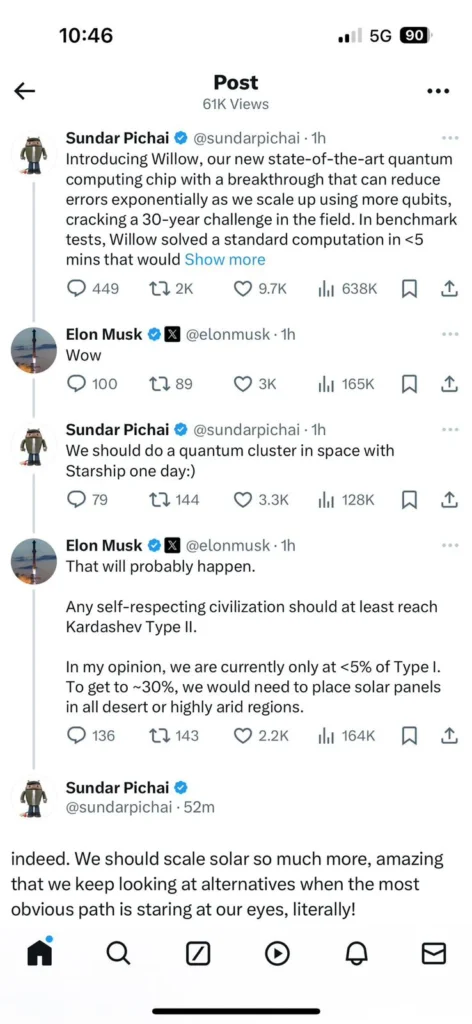
Google’s quantum chip, Willow, has taken the tech world by storm. The chip, unveiled on Monday, solved a complex problem in less than five minutes – a task so complex that it would take a conventional computer 10 septillion years to solve it (yes, that’s a 1 followed by 25 zeros). This astonishing leap in quantum computing, created at Google’s Santa Barbara lab, is a strong step toward the future of technology. Google CEO Sundar Pichai happily announced the breakthrough on his X (formerly Twitter) account, portraying Willow as a “state-of-the-art quantum chip” capable of scaling while minimizing errors – a feat that was thought to be impossible until now. Elon Musk responded with his signature one-word response: “Wow.” But the discussion didn’t stop there. Pichai casually floated the idea of creating a “quantum cluster in space” with Musk’s Starship, to which Musk replied, “It’s likely to happen.” The futuristic Musk turned the conversation towards Kardashev’s second-generation civilizations, sun-powered boards in the desert, and humanity’s increasing tendency towards dealing with global energy. Pichai responded as well, stressing on increasing sun-powered energy rather than constantly exploring alternatives. In true tech-titan style, the trade turned into a stupid brainstorming session – parts-driven and also with fascinating. While the world marvels at Willow’s quantum potential, Musk and Pichai appear poised to take computing (and mankind) to interstellar heights. Quantum clusters in space? Who wouldn’t go “wow” at that? The Willow chip represents a crucial step towards overcoming one of quantum computing’s biggest challenges: error prevention. Equipped with 105 qubits – the basic building pieces of quantum computation – Willow is designed to deal with the unimaginable speed of qubits, while keeping in mind their defenselessness towards tiny disturbing effects like subatomic particles, which often cause mistakes. Traditionally, increasing the number of qubits on a chip exacerbates these problems, hindering performance.

However, Google’s inventive approach with Willow has flipped the script. By carefully combining the chip’s qubits, the tech giant manages to reduce error rates as the qubit number increases – a feat that has long been considered a major leap forward in the field. More remarkable in fact, Google claims that it can currently adjust these errors in real-time, which is a significant improvement in making quantum computers practical for understanding real-world problems.
Hartmut Neven, head of Google Quantum AI, underscored the success, saying, “We have gone beyond the break-even point.” With this achievement, Willow has cleared the way for quantum computing to tackle challenges in fields such as medicine, artificial intelligence and energy development – areas where conventional computers fail.







